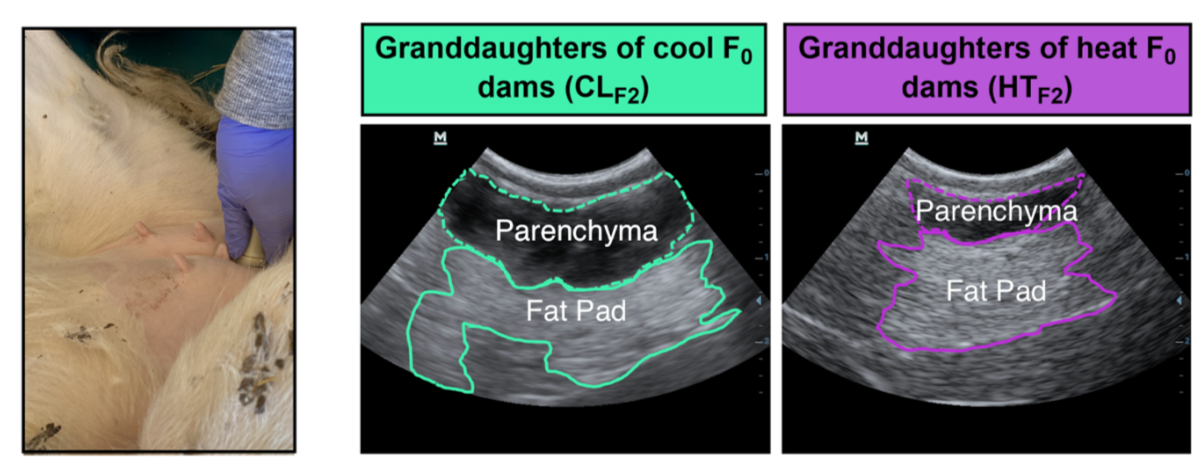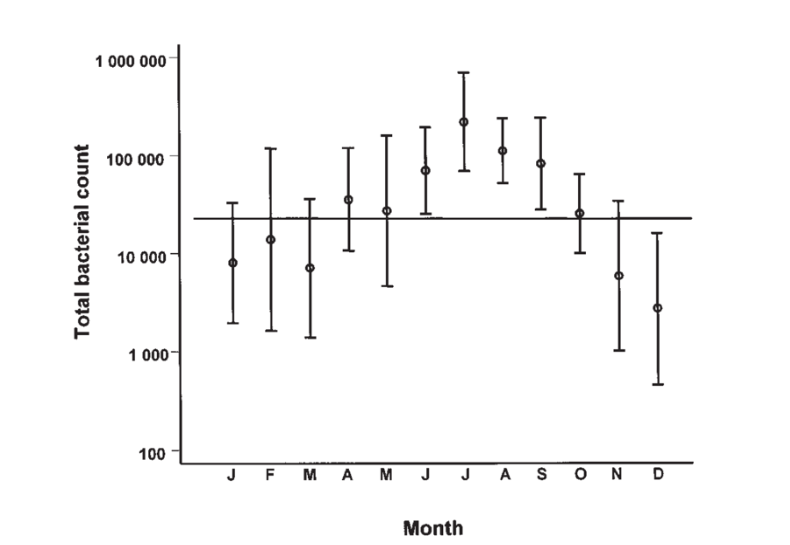Refreshing considerations for the warm months: the importance of cooling dry cows and adjusting colostrum management practices
- 19, June 2024
New findings continue to improve our understanding of the impact that heat stress during the dry period has on cows’ subsequent lactations and the future performance of their progeny. This motivated me to summarize recent and previous findings that highlight the importance of cooling dry cows and of adapting our colostrum management practices to help cows and calves thrive as the weather warms up.
Heat stress (Temperature-Humidity Index > 68; find a comprehensive chart here) is an important disruptor for cows at all life stages. However, its impacts during the dry period are particularly profound, affecting:
1. The cow’s own lactation performance:
Past research from the Dr. Dalh’s group at University of Florida had clearly demonstrated that milk production is reduced during the entire lactation (5 kg/d) when cows suffered heat stress during their entire dry period (Tao et al., 2011).
A recent study (Fabris et al., 2019) presents new findings about the effectiveness of cooling cows during the early (first 3 weeks), late (4th week until calving) or the entire dry period (~45 days) to abate the negative effects of heat stress. They found that:
- During the early dry period, cooling increased dry matter intake and body weight gain but these variables did not differ among treatments during late dry period.
- Heat stress at any time reduced gestation length by about 4 days compared with cows cooled during the entire dry period.
- Cows that are exposed to heat stress at any time during the dry period have reduced milk yield in the subsequent lactation. Interestingly, fat yield did not differ.
- Providing cooling only in the early or late dry period partially rescued milk yield only for the first 3 weeks of lactation.
- Cooling for the entire dry period increased milk yield up to 30 weeks into lactation, when compared with all other treatments.
2. Daughter and granddaughter performance:
Heat stress doesn’t only affect mom, but also her daughters and granddaughters. Past research has characterized the multiple negative impacts of the maternal exposure to late-gestation heat stress on the daughter (slowed growth, altered mammary gland development, greater risk to culling prior calving and reduced life-long milk production), but less is known on the granddaughters (greater risk of being culled prior calving and reduced first lactation yield). A recent study from University of Wisconsin-Madison (Larsen and Laporta, 2024) provides further insights on heat stress impacts on this second generation:
- Birth weight, growth and starter intake preweaning were not affected.
- Phenotypical anatomy of the mammary gland remained the same.
- The development of the mammary gland is affected by 70 days of life which could explain the altered milk yield during the first lactation.
- Compared to the granddaughters from cows that were cooled during late gestation, the granddaughters coming from cows exposed to heat stress during the late gestation had lower parenchyma[1] mass (Figure 1.), less developed functional structures and fewer estrogen receptors.

Figure 1: Ultrasonographic analysis of 70-day-old-heifer’s mammary glands. Photos of visible mammary parenchyma and fat pad. Adapted from Larsen and Laporta, 2024.
[1] The parenchyma is the functional portion of organ tissue— in this case, the mammary tissue.
3. Colostrum and transfer of passive immunity:
As observed with milk yield, colostrum yield is reduced in cows exposed to heat stress during their dry period.
Although the immunological quality of colostrum seems to not be affected by heat stress, the microbiological quality of the colostrum given to calves worsens during the warm months. A Canadian study (Fectau et al., 2002) found that during the warm months (average temperature >4°C) the relative risk of important bacterial contamination (> 100,000 CFU/mL) was 2.55 times greater than in the cool months (Figure 2). This increased risk was related to the greater delay between collection and feeding of colostrum and accelerated bacterial growth in the warmer months. The increased workload characteristic of the season could lead to less time available to effectively cover calf-related chores in the warm months which could result in longer incubation times, less effective sanitation and ultimately in greater bacterial contamination.
A recent study in which Lactanet collaborated also observed a seasonal trend in the cleanliness of feeding equipment, being less effective on the spring and summer months (Van Driessche et al., in press). A grater bacterial load will not only impair the absorption of immunoglobulins in colostrum but may also expose the calf to early infections at a particularly susceptible stage.
After collection, colostrum should be immediately fed, refrigerated or frozen.

Figure 2: Total bacterial count on colostrum samples taken during each month of the year. Mean and 95% confidence interval displayed. (Fectau et al., 2002)
On top of that, the group from University of Florida (Tao et al., 2012) clearly demonstrated that in-utero heat stress significantly impairs the newborn’s ability to absorb the IgG (immunoglobulin G) present in colostrum, leaving the calf less protected against potential immune challenges.
Thus, without implementing adequate preventive conditions, warm weather represents an immediate and multi-generational detractor for optimal health and performance of cows and their calves. Different strategies to cool dry cows should be considered if this has not been done at the farm.
An economic analysis of Laporta et al. (2020) demonstrated that providing colling to dry cows pays off, even in conditions similar to those in Canada. Lastly, adjusting colostrum management practices and ensuring proper equipment sanitation will help preserve colostrum quality.
References
Fabris, Thiago F., Jimena Laporta, Amy L. Skibiel, Fabiana N. Corra, Bethany D. Senn, Stephanie E. Wohlgemuth, Geoffrey E. Dahl. 2019. Effect of heat stress during early, late, and entire dry period on dairy cattle. J Dairy Sci.102: 5647-5656. https://doi.org/10.3168/jds.2018-15721
Fecteau G, Baillargeon P, Higgins R, Paré J, Fortin M. 2002. Bacterial contamination of colostrum fed to newborn calves in Québec dairy herds. Can Vet J. 43(7):523-527. PMID: 12125183
Larsen GA and Laporta J. 2024. Carry-over effects of maternal late-gestation heat stress on granddaughter’s growth and mammary gland development. J Dairy Sci. S0022-0302(24)00764-1. https://doi.org/10.3168/jds.2024-24678
Laporta J, Ferreira FC, Ouellet V, Dado-Senn B, Almeida AK, De Vries A, Dahl GE. 2020. Late-gestation heat stress impairs daughter and granddaughter lifetime performance. J Dairy Sci. 103(8):7555-7568. https://doi.org/10.3168/jds.2020-18154
Tao S, J.W. Bubolz, B.C. do Amaral, I.M. Thompson, M.J. Hayen, S.E. Johnson, G.E. Dahl. 2011. Effect of heat stress during the dry period on mammary gland development. J Dairy Sci. 94(12):5976-5986. https://doi.org/10.3168/jds.2011-4329
Tao S, Monteiro AP, Thompson IM, Hayen MJ, Dahl GE. 2012. Effect of late-gestation maternal heat stress on growth and immune function of dairy calves. J Dairy Sci. 95(12):7128-7136. https://doi.org/10.3168/jds.2012-5697
Van Driessche L, Santschi DE, Paquet É, Renaud DL, Charbonneau É, Gauthier ML, Steele MA, Chancy A, Barbeau-Grégoire N, Buczinski S. In press. Association between ATP luminometry of feeding equipment and environmental and health parameters of preweaned calves on dairy farms. J Dairy Sci. https://doi.org/10.3168/jds.2024-24700







